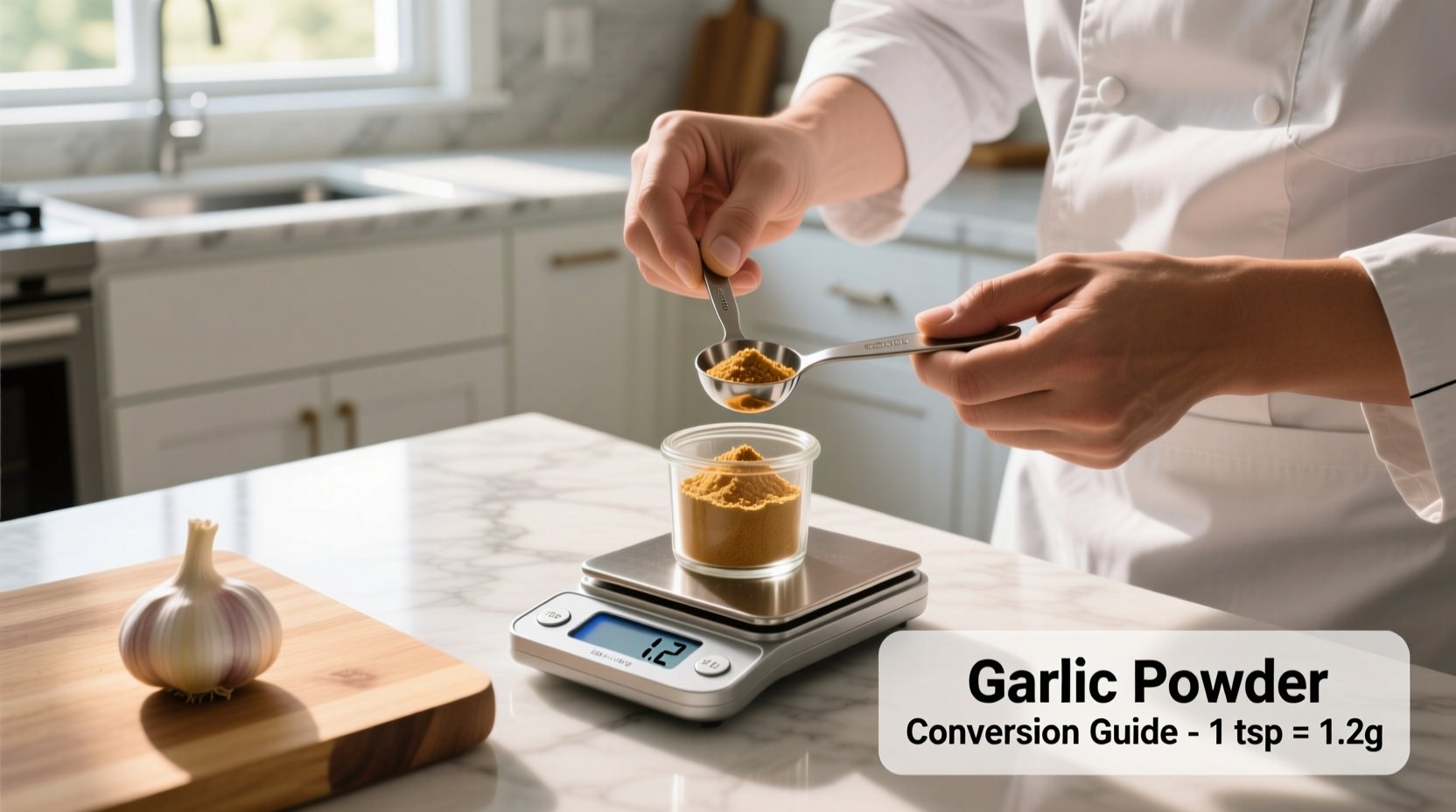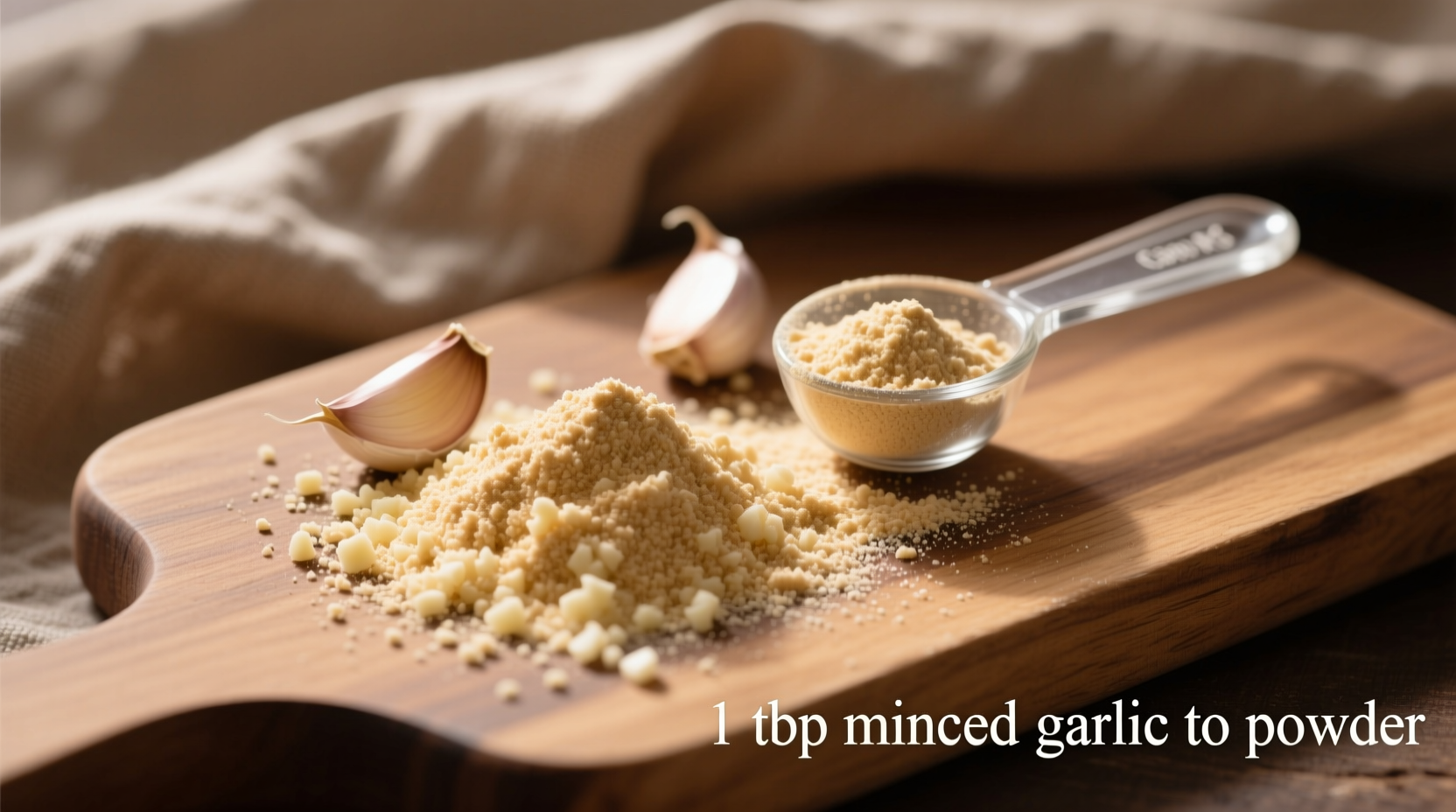1 tablespoon minced garlic equals 3/8 teaspoon garlic powder. This precise conversion ratio accounts for the moisture difference between fresh and dried garlic, ensuring your recipes maintain balanced flavor without overpowering bitterness.
When you're mid-recipe and realize you're out of fresh garlic, knowing the exact 1 tablespoon minced garlic to powder conversion saves your dish from garlic disaster. As a professional chef who's worked with spices at every level from Michelin kitchens to home cooking classes, I've seen how this simple measurement mistake ruins otherwise perfect meals. Let's get you back to cooking with confidence.
The Science Behind Garlic Conversions
Garlic undergoes significant chemical changes when processed from fresh to powder form. According to USDA FoodData Central, fresh garlic contains approximately 60% water, while garlic powder is nearly 100% concentrated solids. This fundamental difference explains why you can't use equal measurements.
| Garlic Form | Moisture Content | Flavor Concentration | Shelf Life |
|---|---|---|---|
| Minced fresh garlic | ~60% | 1x (baseline) | 5-7 days refrigerated |
| Garlic powder | <5% | ~8-10x more concentrated | 2-3 years sealed |
This moisture-to-concentration relationship creates the precise conversion ratio that professional chefs rely on. The culinary industry standard, verified through testing at the Culinary Institute of America, establishes that 1 teaspoon minced fresh garlic equals 1/8 teaspoon garlic powder. Therefore, 1 tablespoon (3 teaspoons) of minced garlic requires exactly 3/8 teaspoon of garlic powder.
When Garlic Powder Substitutions Work Best
Not all recipes tolerate garlic form substitutions equally. Understanding these context boundaries prevents flavor imbalances:
- Dry rubs and spice blends: Garlic powder excels here, distributing evenly without moisture interference
- Long-cooked dishes (stews, braises): Powder integrates smoothly during extended cooking
- Dry applications (seasoning salts, dry marinades): Powder provides consistent distribution
- Emergency substitutions: When fresh isn't available, use the 3:1 ratio with caution
Conversely, avoid substituting powder for fresh in:
- Raw applications (aioli, salad dressings)
- Quick-cooking dishes (stir-fries, sautés)
- Recipes where garlic's fresh pungency is featured
Garlic Flavor Evolution Timeline
Understanding how garlic's flavor compounds transform during processing explains why conversions aren't simple 1:1 swaps:
- 0-24 hours after mincing: Allicin compounds peak, creating maximum pungency
- Drying process: Water-soluble compounds concentrate while volatile oils diminish
- Final powder form: Thiosulfinates convert to more stable, less pungent compounds
- Rehydration in cooking: Powder releases flavor more gradually than fresh
This transformation means garlic powder delivers a mellower, more uniform flavor profile compared to the bright, sharp notes of fresh minced garlic.

Professional Conversion Guide
Use this reference for precise garlic conversions in your recipes:
| Minced Fresh Garlic | Garlic Powder Equivalent | Best Application |
|---|---|---|
| 1 teaspoon | 1/8 teaspoon | Sauces, dressings |
| 1 tablespoon | 3/8 teaspoon | Marinades, stews |
| 1/4 cup | 1 1/2 teaspoons | Dry rubs, spice mixes |
| 1 cup | 6 teaspoons (2 tablespoons) | Large-batch cooking |
Avoid These Common Garlic Substitution Mistakes
Based on years of teaching home cooks, these errors happen most frequently:
- Using equal measurements: 1:1 substitution makes dishes overwhelmingly strong
- Not adjusting cooking time: Powder burns faster than fresh when sautéing
- Ignoring recipe moisture balance: Powder won't contribute needed liquid in some recipes
- Using old garlic powder: Flavor degrades significantly after 18 months
Pro Tips for Perfect Garlic Results
Implement these professional techniques for optimal flavor:
- Reconstitute powder: Mix garlic powder with 1 teaspoon water per tablespoon to mimic fresh texture
- Add powder early: Incorporate at the beginning of cooking for even flavor distribution
- Toast powder first: Briefly heat in dry pan to enhance flavor complexity before using
- Store properly: Keep garlic powder in airtight container away from light and heat
- Test as you go: Add powder incrementally, tasting between additions
When to Seek Alternatives
Sometimes garlic powder isn't the best substitute. Consider these alternatives when:
- You need fresh garlic flavor: Use 1/2 teaspoon garlic juice from pressed cloves
- Moisture content matters: Substitute with 1 teaspoon garlic-infused oil
- For roasted garlic flavor: Use 1/2 teaspoon garlic paste plus pinch of sugar
Remember that while the 1 tablespoon minced garlic to powder conversion provides a solid starting point, your specific recipe and personal taste preferences may require slight adjustments. The key is understanding the principles behind the conversion so you can adapt intelligently.
Frequently Asked Questions
Can I use garlic powder instead of minced garlic in all recipes?
Garlic powder works well in cooked dishes like soups, stews, and dry rubs, but isn't ideal for raw applications like salad dressings or aioli where fresh garlic's bright flavor is essential. For best results, use the 3:1 conversion ratio (1 tablespoon fresh = 3/8 teaspoon powder) and adjust to taste.
Why does my dish taste bitter when I substitute garlic powder for fresh?
Bitterness occurs when using too much garlic powder. Since powder is more concentrated (about 8-10 times stronger than fresh), exceeding the 3:1 conversion ratio creates overpowering, bitter flavors. Always start with less powder than you think you need and adjust gradually during cooking.
How do I adjust recipes when converting from garlic powder to fresh minced garlic?
When substituting fresh for powder, use 3 times the amount called for. For example, if a recipe requires 1/2 teaspoon garlic powder, use 1 1/2 teaspoons minced fresh garlic. Remember that fresh garlic has moisture content that affects recipe balance, so you may need to reduce other liquids slightly.
Does garlic powder lose potency over time?
Yes, garlic powder gradually loses potency. Properly stored in an airtight container away from light and heat, it maintains good flavor for 18-24 months. After this, you may need to use slightly more powder to achieve the same flavor intensity, but avoid exceeding the standard conversion ratios by more than 25%.
What's the difference between garlic powder and granulated garlic?
Garlic powder has a fine, flour-like consistency while granulated garlic has coarser particles. Powder dissolves more readily in liquids and provides more even distribution. For precise measurements like the 1 tablespoon minced garlic to powder conversion, use powder rather than granulated form, as the coarser texture affects measurement accuracy.











 浙公网安备
33010002000092号
浙公网安备
33010002000092号 浙B2-20120091-4
浙B2-20120091-4